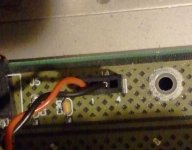Trixter
Veteran Member
I'm currently restoring an AT&T 6312 WGS and the battery lasts about 10 seconds before completely discharging, which means I have to keep going into the setup program to re-set everything including the hard drive tables. I want to replace this, but I'm not quite sure what the best way to do it is -- I can't just replace it with two AA batteries because the charging aspect might explode them, and also I don't think they'd provide enough voltage. Pictures are below:




